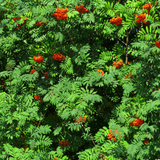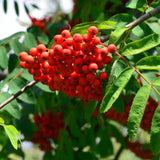90/120cm Bare Root Rowan
(Sorbus Aucuparia)
Sorbus Aucuparia is a lovely, deciduous, native hedge that blooms creamy-white flowers from May or June, featuring an elegant, sweet fragrance.
- About Bare Root Rowan Hedging
- Key Features
- Pruning & Care
Rowan hedging flowers soon turn into orange-red coloured berries in the Autumn, complementing the leaves which change the same colour before they drop off. The delicious berries are loved by the birds and can easily be eaten by humans, too- they make lovely jams and jellies!
Once you receive your Rowan Bare Root plant, it will need to be planted as soon as possible (within a couple of days)- the roots are tender and cannot be left to dry out.
This 90/120cm bare root Rowan plant has an average growth rate, but can reach above 2.5m high when planted in good conditions.
Rowan hedging is tolerant to the unpredictable UK weather conditions, and is best planted in normal, well-drained soil- directly in the sun.- Growth height: Average (20-40cm per year)
- Ideal height: 2.5m+ Tall
- Soil type: Normal
- Exposure: Coastal, exposed, inland, sheltered
- Aspect: Semi-shade, full sun
- Evergreen foliage? No
As soon as you receive your Rowan Bare Root plant, place it into a bucket of water for at least 2 hours. The roots must be wet before planted. You will have to continually water Rowan hedging after being planted, too, as this ensures solid growth and establishment (though the soil must be well-draining, as it cannot be left to become waterlogged).
In terms of pruning etc., the plant must be trimmed during late Autumn/Winter, during the dormancy period. You should only trim during this time as you do not want the plant to bleed a white sap that will lead it to being open to diseases. We also recommend growing Rowan hedging on its own and giving it a yearly trim to retain strength and shape.
If you notice any dead wood, make sure you trim back the live growth (this can be done at any time during the year)- doing so will ensure new, strong, healthy growth, along with better berry/flower production during Spring.

Berries

Tall

White Flower
Sorbus Aucuparia is a lovely, deciduous, native hedge that blooms creamy-white flowers from May or June, featuring an elegant, sweet fragrance.
- About Bare Root Rowan Hedging
- Key Features
- Pruning & Care
Rowan hedging flowers soon turn into orange-red coloured berries in the Autumn, complementing the leaves which change the same colour before they drop off. The delicious berries are loved by the birds and can easily be eaten by humans, too- they make lovely jams and jellies!
Once you receive your Rowan Bare Root plant, it will need to be planted as soon as possible (within a couple of days)- the roots are tender and cannot be left to dry out.
This 90/120cm bare root Rowan plant has an average growth rate, but can reach above 2.5m high when planted in good conditions.
Rowan hedging is tolerant to the unpredictable UK weather conditions, and is best planted in normal, well-drained soil- directly in the sun.- Growth height: Average (20-40cm per year)
- Ideal height: 2.5m+ Tall
- Soil type: Normal
- Exposure: Coastal, exposed, inland, sheltered
- Aspect: Semi-shade, full sun
- Evergreen foliage? No
As soon as you receive your Rowan Bare Root plant, place it into a bucket of water for at least 2 hours. The roots must be wet before planted. You will have to continually water Rowan hedging after being planted, too, as this ensures solid growth and establishment (though the soil must be well-draining, as it cannot be left to become waterlogged).
In terms of pruning etc., the plant must be trimmed during late Autumn/Winter, during the dormancy period. You should only trim during this time as you do not want the plant to bleed a white sap that will lead it to being open to diseases. We also recommend growing Rowan hedging on its own and giving it a yearly trim to retain strength and shape.
If you notice any dead wood, make sure you trim back the live growth (this can be done at any time during the year)- doing so will ensure new, strong, healthy growth, along with better berry/flower production during Spring.




